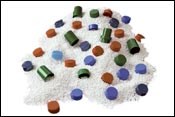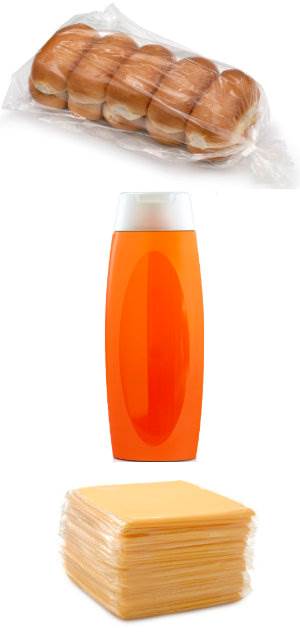Taste and Odor: Understand the Role of Colorants and Additives In Food and Beverage Packaging
Do you know how masterbatch ingredients, processing, storage, and handling can affect taste and odor in packaged products? Here’s an introduction to the numerous factors in organoleptic properties and how they are measured.
An important goal in creating packaging for foods, beverages, and other goods sensitive to taste and odor is to minimize sensory change as much as possible over the shelf lives of these products. Preserving the taste and odor of products in plastic packaging is a complex process that extends throughout a package’s path from formulation to customer.
Even as plastic packaging protects its contents, it can alter their taste and odor. In most cases this is subtle and of little consequence. In some cases, the change can be critical. A glaring example is neutral products like bottled water that are especially susceptible to organoleptic influences. Given the resources that food, beverage and other manufacturers expend in creating compelling products, the last thing they need is to have a plastic package alter the taste and odor of their offerings.
More and more, everyone involved in the chain of the package’s creation, from the additive masterbatch suppliers and compounders to molders and extruders, are asked to validate that a package won’t cross-contaminate a food or a beverage. This makes it critical to ensure that the materials used and the processing steps followed affect the taste or odor of the contents—their organoleptic qualities—as little as possible.
Taste and odor issues most often occur when a component in the plastic migrates into the contents of the package, although other mechanisms such as “scalping” (chemical interaction between the package and its contents) may also be present. An important initial step is to learn which package ingredients cause off-flavors and aromas so the additive and resin combination chosen has minimal organoleptic impact.
Once package prototypes have been developed, the choice of packaging raw materials is often confirmed by taste and odor panels and perhaps by analytical methods. Getting the package formulation right the first time saves time and money in package development, accelerates time to market, and eliminates costly packaging rework and requalification later on. It also ensures consumer acceptance.
Color & additive effects
Understanding how resins, colorants, and functional additives affect product taste and odor is essential to being able to limit the organoleptic interaction between the plastic package and its contents. Since any packaging raw material can cause organoleptic concerns, masterbatch suppliers and others involved in compound formulation must know how various pigments, resins, and additives affect taste and odor.
The ability to make informed choices about these components begins with testing of raw materials to create a database of organoleptic properties. Such a database has two aspects. One is based on a company’s knowledge of pigments and additives and how they affect taste and odor. The other is empirical and is based on how taste and odor panels have evaluated packaging that contains certain colorants and additives. Organoleptic qualities of new grades of colorants and additives are evaluated in light of the existing database, as most of these new products are enhancements of current products and rely on known chemistries.
The optimum approach to creating plastics packaging free of taste and odor problems is to choose an “organoleptic-friendly” colorant and avoid the use of functional additives. In general, most FDA-compliant colorants are organoleptically suitable. Still, colorants require careful selection because some have chemistries that are more problematic than others when it comes to taste and odor. Many formulators avoid colorants that contain either chlorine or sulfur due to their potential to cause sensory issues, and some manufacturers have strict limits on compounds with such colorant content. Ultramarine blue pigment, with its residual sulfur, is one such example.
Off-tastes can also arise from coatings on mineral pigments, such as rutile titanium dioxide (TiO2), which are often designed to assist dispersion. In fact, only a few of the TiO2 white pigments currently available are suitable, which makes it imperative for those formulating masterbatches for plastic packaging to monitor such pigments from all suppliers
Careful consideration is also required when selecting organic additives used in packaging resins, including slips used for torque reduction in closures or as a mold release, antioxidants for protection against thermal degradation, antistats, and dispersion agents that aid in the manufacturing process.
To avoid organoleptic problems, formulators should opt for high-purity additives that contain relatively low concentrations of lower-molecular-weight contaminants that readily migrate out of a plastic. Formulators should also use these additives at the lowest effective dosage. Those made from vegetable sources are generally preferred to those derived from animal sources, which may go rancid over time. Primary slips are a good example, with formulators gravitating to vegetable-based erucamide types over animal-based oleamide slips.
Another key is to minimize or eliminate organic functional groups such as amines, amides, esters, ethers, and hydroxyls, which contain heteroatoms (oxygen, nitrogen, phosphorous, sulfur) that are typically migratory and impact taste and odor. For example, this means avoiding antistats based on amine or ester chemistries and antioxidants that use combinations of phosphates and either hindered phenols or thiol esters.
Other considerations
Several other factors can weigh in on the organoleptic integrity of a package. Among them is the choice of carrier resins used in masterbatches. These should be neat resins that are free of low-molecular-weight components.
Even when formulating with a high level of organoleptic awareness, problems can arise during processing. To safeguard against cross-contamination, packaging manufacturers should consider using dedicated equipment whenever possible for applications sensitive to taste and odor.
Shelf-life is also an issue with masterbatches designed for an organoleptic-sensitive application, because ad-ditives can degrade as they age. Such masterbatches usually have shelf lives of six months or less, as opposed to two years for conventional masterbatches. The shorter shelf lives prevent migratory components in the masterbatch from traveling to the pellet surfaces. Good manufacturing practices regarding inventory turnover is a requirement to ensure product viability.
Molders and extruders need to keep processing temperatures from rising so high that the resin degrades and creates species that cause offensive odors and tastes. The rest of the supply chain can also create organoleptic problems. For example, sterilization by ultraviolet light or ozone can affect some of the organic additives in a plastic to create off-tastes and odors. Even distribution and storage can alter taste and odor if the package shelf life is exceeded or storage temperature goes too high.
Organoleptic screening
Taste and odor are psychophysical phenomena that vary from person to person. As subjective perceptions, they are best evaluated by panels of carefully selected individuals trained to detect them. Packagers of beverages like wine, liquor, coffee, and water, as well as foods, drugs, perfumes, cosmetics, and other fragrant health and beauty aids, have a long history of reliance on taste and odor panels to assess aroma and flavor.
Molders and manufacturers often use such panels to screen prototype packaging to see if the organic and inorganic ingredients and processing method used affect the organoleptic integrity of the contents. Testing panels are also used in quality-control programs during production to evaluate incoming raw materials or respond to customer complaints. Panels also come into play after a package is reformulated.
Much thought has been given to how to gain dependable results from taste and odor panels (see sidebar). Their use typically involves blind studies in which test samples are evaluated against a control. Panels may simply rate the difference between samples and a control as pass-fail or, they may rank the taste and odor intensity of samples based on set descriptions—e.g., no difference, slight difference (acceptable), moderate difference (problematical), and pronounced differences (rejected). Such descriptors are often assigned numerical values—e.g., zero for no difference, 0 to 1 for a slight difference, and so forth. Panel members rate samples along the spectrum defined by the scale so the results can be analyzed statistically.
Taste and odor panels contain four to 15 or more individuals selected from the local community who represent a cross-section of age and gender. The overall goal is to have all panel members assess samples in the same way. Recruits are tested for sensitivity to tastes and odors using standard odorants to ensure they are not hypersensitive or lack sensitivity to odors. They cannot be smokers and they must be free of physical conditions that affect smell or taste, such as colds, allergies, and asthma. Those accepted are trained in sensory awareness, the descriptors to be used, and how to behave on the panel (such as to avoid biasing others on the panel with one’s perceptions during testing).
Panels operate in a controlled environment free of odors, noise, and other distractions, and are asked not to chew gum or eat just before or during testing, to not wear perfume and other scented items, and to keep their hands and clothes clean and free of odors. All samples are prepared and presented to panel members in the same way.
Data from taste and odor panels is often all that is needed to ensure a product is suitable for its intended use. Such panels remain the most consistent and practical method for determining if a package is suitable for a food or beverage application.
At times there is a need to identify offending substances in a package so the source of the problem can be found and corrected. Characterizing such substances is a daunting and time-consuming task. While gas chromatographs (GC) and mass spectrometers (MS) provide objective measurement of specific chemicals, this approach is limited because flavor involves trace levels of a great many compounds interacting with the human sensory apparatus.
An effective approach to identifying compounds that cause odor quality defects combines conventional gas chromatograph and mass spectroscopy (GC-MS) methods with olfactometry and multidimensional GC separation techniques. An example is the AromaTrax system from Microanalytics (see photo). This approach compares odorant spectroscopic profiles for best-case samples with worst-case ones, perhaps as identified by a taste and odor panel, to help identify the compounds that account for this difference.
Tom Mickey, senior technical service specialist, joined Ampacet in 1979 and has specialized in colorants, additives, and molding issues. He has been responsible for organoleptic development at the company since 2001. Rich Novomesky, strategic business manager, joined Ampacet in 1996 and has a broad background in masterbatches, packaging, and food processing.
Related Content
Surface-Activating Primer for Polyolefins and Fluoropolymers
XlynX Materials’ PlastiLynx is designed for use with low-surface-energy polymers for improved bonding and printing.
Read MoreVibrantz Technologies’ Leadership Changes
Formerly Chromaflo and Ferro, Vibrantz announces shifts in leadership roles.
Read MoreGraphene-Enhanced Stretch Film Billed as 'World First'
Thinner, stronger films to be commercialized by Brazil’s Packseven in August.
Read MorePFAS-Free Processing Aid for Blown Film Extrusion
Ampacet’s new processing aid said to perform as well as fluoro-based PPAs in blown film.
Read MoreRead Next
Processor Turns to AI to Help Keep Machines Humming
At captive processor McConkey, a new generation of artificial intelligence models, highlighted by ChatGPT, is helping it wade through the shortage of skilled labor and keep its production lines churning out good parts.
Read MoreUnderstanding Melting in Single-Screw Extruders
You can better visualize the melting process by “flipping” the observation point so that the barrel appears to be turning clockwise around a stationary screw.
Read MoreHow Polymer Melts in Single-Screw Extruders
Understanding how polymer melts in a single-screw extruder could help you optimize your screw design to eliminate defect-causing solid polymer fragments.
Read More
































